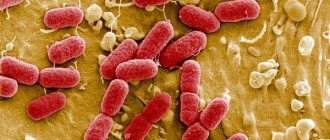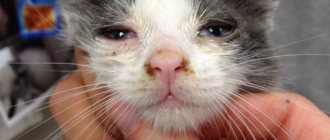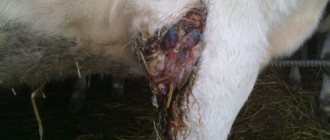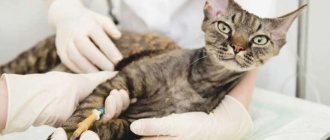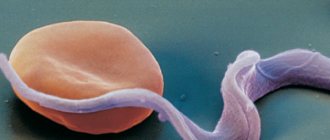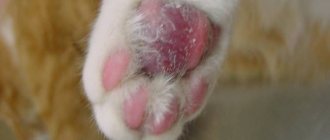Tuberculosis is one of the most dangerous infectious diseases for both humans and animals. The causative agent that causes it is the so-called mycobacteria. This is a genus of aerobic, slow-growing rod-shaped microorganisms, including about thirty species. Most representatives of this genus are capable of causing severe illnesses in vertebrates that are difficult to treat (tuberculosis, leprosy, various mycobacterioses). In this article we will look at tuberculosis in cats, how this disease progresses, characteristic symptoms, danger to others, as well as methods of its treatment and prevention.
General information
Animals get sick mainly in two ways:
- airborne - during contact between sick and healthy individuals;
- nutritional or contact - through contaminated household items, when eating contaminated food, meat or milk of sick animals, as well as during mouse hunting.
The following felines are at risk:
- animals kept in a nursery in poor sanitary and hygienic conditions. They become infected from each other;
- animals with impaired immunity. Their body cannot resist the infection, and they become very ill;
- small kittens and older animals. The disease is transmitted to them more often than to young and strong cats.
Course of the disease
The course of tuberculosis is characterized by two stages - primary and secondary. A cat becomes infected, in most cases, through the lungs, in more rare cases - through the oral cavity, broken skin, and even through the mucous membrane of the eyes. The immune system, when activated, produces antibodies to the pathogen.
A primary focus of inflammation is formed at the site of infection. These are, first of all, the respiratory organs, tonsils, and pharynx. In second place are the skin, intestines, and lymph nodes. Subsequently, the infection spreads through the blood throughout the body, involving other organs and systems in the process. Foci of tuberculosis can also form there. With strong immunity, they encapsulate (heal) over time, and the disease becomes a closed form. The cat becomes a carrier of the infection. In unfavorable conditions (especially during cold periods), with a sharp decrease in immunity in the foci, the process may be activated. The disease will take a generalized form and enter the stage of secondary tuberculosis.
Clinical picture
Depending on the location of the lesion and the type of mycobacterium, several types of tuberculosis are distinguished in cattle:
- Pulmonary tuberculosis.
- Intestinal damage.
- Tuberculosis of the uterus and the reproductive system as a whole.
- Tuberculosis of the udder.
- Generalized damage to the body. That is, the infection has spread throughout the animal’s body.
Depending on the location of the source of infection, the animal exhibits different symptoms. In adult animals in the early stages, signs of the disease are erased. In its acute form, the disease develops only in young individuals.
- The temperature rise is constant.
- Loss of weight and appetite.
- Dyspnea.
- Cough with sputum. At the beginning of the disease, the cough is sharp and infrequent, and then becomes more frequent, sometimes with groans. The mucus may contain blood and necrotic tissue.
- When listening to the animal's chest, clear wheezing is detected.
- Severe swelling of the retropharyngeal and submandibular lymph nodes in the neck. May be accompanied by drooling and suffocation.
- If the udder is affected, then when the cow is milked, there may be blood and curdled masses in the milk. The lymph nodes near the udder enlarge, become dense and lumpy.
- In the intestinal form of tuberculosis, foul-smelling diarrhea with bloody or purulent impurities is observed. Diarrhea alternates with constipation and intestinal colic, which cause significant discomfort to the animal. The depletion of the animal's body in the intestinal form of the disease is rapid due to the fact that food is not digested.
- If the animal has a generalized form of the disease, then enlarged lymph nodes throughout the body are added to all the symptoms listed above.
Symptoms of the disease
Feline tuberculosis has symptoms that vary depending on where the infection occurred. Until the generalization of the process occurs, one organ or group of organs that were the first to encounter the action of mycobacteria suffers.
- With the nutritional route of infection (through contaminated meat, milk, or from infected mice during hunting), the intestines are the first to suffer. Tuberculomas (foci of lesions) form there, causing symptoms of intestinal intoxication: diarrhea, vomiting, weight loss.
- When in contact with sick brothers (most often during fights), the first signs of tuberculosis look like non-healing wounds on the skin and enlarged lymph nodes (most often peripharyngeal). Sometimes the infection penetrates deeply and affects the muscles and bones. Skin tuberculosis can occur in one of three forms: focal lesions, nodular subcutaneous tuberculosis or tuberculous tumor-like lesions.
- If an animal receives an infection through airborne droplets, the lungs are affected. Characteristic signs of this form are a persistent barking cough and heavy breathing. Subsequently, pulmonary hemorrhages are possible. Tuberculous pharyngitis may occur, accompanied by inflammation of the tonsils. This form of tuberculosis often resolves with the addition of secondary infections, since the body's resistance drops dramatically.
- Eye tuberculosis has the form of conjunctivitis, complicated by inflammation of the eyelids. In rare cases, it may be accompanied by the formation of tuberculous granulomas on the eyeballs.
- Generalized tuberculosis has the most severe symptoms, as it affects all organs and systems. The most important symptom is a sharp drop in the body's resistance, which is characterized by poor healing of wounds and skin damage. Symptoms of intoxication increase - diarrhea, vomiting, loss of appetite, weight loss, which are combined with increasing weakness, enlarged lymph nodes. At this stage the disease is most contagious.
Can a person get infected from a cat and vice versa?
All viruses and bacteria that lead to the development of tuberculosis are contagious. They are transmitted both from owners to animals and vice versa. Of course, this depends on the strain of bacteria. In some cases, the risk of transmission of tuberculosis from a cat to its owner is low, however, it is not zero. If the question concerns Mycobacterium bovis, then everything is serious here. In this case, doctors strongly advise against treating the cat, because the risk of transmitting tuberculosis to the owner is quite high.
This is really no joke. There was a case in history when people had to slaughter an entire herd of cows just because the owner had an open form of tuberculosis. In this way people prevented the epidemic.
Diagnostic measures
Tuberculosis is diagnosed in cats, as in the case of the disease in humans, using chest radiography and ultrasound examination. Only they make it possible to determine whether there are damage to internal organs and what their degree is. But sometimes, in case of a questionable diagnosis, a clarifying diagnosis is necessary:
- A blood test is needed to identify abnormalities in its composition and a deficiency of certain microelements (characteristic of tuberculosis infection). This is, for example, the presence of anemia and hypercalcemia in the intestinal form of tuberculosis.
- The method of staining microorganisms with special solutions is used (Ziehl-Neelsen method). In this case, their property of reacting differently to certain dyes is used.
- Biopsy and histology of microscopic areas of affected tissue (in particular skin) stained using the Ziehl-Neelsen method are used.
- Animal tissue samples are examined at the biomolecular level using the polymerase chain reaction method.
The research results are analyzed very carefully. If in at least one case there is a small percentage of the probability of infection of the cat, then it is considered presumably sick and is isolated from the rest of the family members.
Diagnostics
Unfortunately, a doctor will not diagnose an animal based on visible signs and symptoms alone. An examination in a good clinic is required, which involves the following steps.
- Ziehl-Neelsen staining of the smear. In order to identify microbacteria in this way, you need a really good specialist who can identify even a small amount of tuberculosis lesions.
- Histology examination, which is part of the smear described above.
- Growing crops in the laboratory. This test allows you to grow the microorganisms found in the smear and study them. Unfortunately, this study takes several months and in some situations will not give results. This diagnostic method is rarely used.
- PCR. The result of this diagnostic method is effective only against some viruses.
As you can see, it is difficult to diagnose tuberculosis in cats. If the doctor succeeds, then he determines the risk of infection for the owner, and then prescribes the best treatment.
Treatment of the disease
All cases of disease in cats must be recorded by the veterinary and sanitary inspection authorities. If tuberculosis is detected in a nursery, it is not recommended to treat the animal. A cat can also be euthanized if it has been infected with a type of mycobacterium that is dangerous to humans.
If a cat is infected with a type of mycobacteria that is not dangerous to humans, it can be treated. Treatment lasts a long time - from several months to several years. Sick animals should be kept away from other family members, including children and animals.
Complex therapy is usually used, prescribing several potent antibiotics. These are broad-spectrum drugs, such as:
- Marbofloxacin;
- Clarithromycin;
- Rifampicin;
- Clofazimine.
Drug treatment of skin tuberculosis is sometimes combined with surgical removal of foci of infection.
People who have been in contact with a sick animal should be observed for some time in an anti-tuberculosis dispensary, as they could become infected from it.
In many cases, treatment is effective, but the overall prognosis of the disease varies from unfavorable to cautious.
Tuberculosis in birds
Many farms keep domestic chickens, ducks, geese, and turkeys. Therefore, poultry tuberculosis needs to be discussed separately. All poultry, regardless of breed, are susceptible to the disease. Many wild birds can also suffer from tuberculosis and be a source of infection. In zoos, cases of tuberculosis have also been reported among exotic birds. Bird tuberculosis can affect warm-blooded animals and humans.
It is unlikely that you will encounter tuberculosis in industrial enterprises and farms, since, as a rule, old birds that are more than a year old get sick from it. Young birds have a strong immune system that does not allow the disease to develop. But there are no old birds at the enterprises, since slaughter occurs before they reach one year of age. Also, at enterprises and industrial farms, birds are given vitamins that increase immunity.
Therefore, tuberculosis in birds occurs in small farms where old birds may be kept.
The source of infection of individuals in poultry farms can be humans or wild birds. The method of infection is mainly nutritional. Infection occurs through contact with sputum and excrement. In dysfunctional farming, tuberculosis is transmitted from chickens to ducks, geese, turkeys and other birds.
The incubation period ranges from 1 month to a year, depending on the age and immunity of the chicken.
Symptoms of the disease increase with the duration of the disease:
- The first signs are fever, weakness, and inactivity.
- Then egg production decreases noticeably.
- Further, with generalized tuberculosis, wrinkling and blanching of the ridge is observed.
- Refusal to feed is accompanied by exhaustion of the body.
- Diarrhea is often present.
- In the final stages of the disease, swelling of the joints and lameness develop.
- With the intestinal form of tuberculosis, rapid depletion of the chicken’s body is observed. Enlarged lymph nodes can be felt through the abdominal wall.
- The chickens quickly weaken and die.
Chickens with tuberculosis lay up to 70% unfertilized eggs. Of fertilized eggs, about 15% of embryos survive. Chickens infected with tuberculosis in the egg do not show signs of the disease until six months, but they release contaminated waste products into the environment and are a source of infection for healthy individuals.
Sick turkeys and ducks, unlike chickens, do not show obvious signs of the presence of the disease. They retain their appetite and plump appearance for a long time, which allows us to think that the birds are healthy. Signs of the disease begin to appear only in the later stages of the disease. Sick ducks and turkeys refuse food and lose weight. The feathers become ruffled, as if wet. Ducks prefer to sit in one place. In ornamental birds, tuberculosis almost always occurs in an open form. If a disease is detected, it is advisable to destroy them, as they can be a source of infection for humans.
Prevention of the disease
Prevention of tuberculosis consists of one thing: minimizing possible contact with infected animals. To do this, you should not let your pets walk alone. Their diet should not include raw meat or milk from “untested” cows. Such food must be thermally processed. Eating caught mice also creates a certain risk of infection.
Monitoring the state of your pet’s immune system and maintaining sanitary and hygienic conditions for keeping it will allow an attentive owner to protect it from such a terrible disease as tuberculosis.
